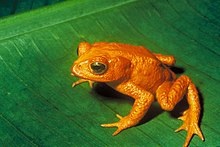 |
| Male golden toad. |
Herpetology
Herpetology (from Greek ἑρπετόν herpetón, meaning
"reptile" or "creeping animal") is the branch of zoology
concerned with the study of amphibians (including frogs,
toads, salamanders, newts, and caecilians (gymnophiona))
and reptiles (including snakes, lizards, amphisbaenids,
turtles, terrapins, tortoises, crocodilians, and the
tuataras). Birds, which are cladistically included
within Reptilia, are traditionally excluded here; the
scientific study of birds is the subject of ornithology.
Thus, the definition of herpetology can be more
precisely stated as the study of ectothermic
(cold-blooded) tetrapods. Under this definition "herps"
(or sometimes "herptiles" or "herpetofauna") exclude
fish, but it is not uncommon for herpetological and
ichthyological scientific societies to "team up",
publishing joint journals and holding conferences in
order to foster the exchange of ideas between the
fields, as the American Society of Ichthyologists and
Herpetologists does. Many herpetological societies have
been formed to promote interest in reptiles and
amphibians, both captive and wild. |
|
|
"Herp" is a vernacular term for reptiles and amphibians.
It is derived from the old term "herpetile". Linnaeus
grouped reptiles and amphibians together in the same
class, and that is where the term comes from. The term
has persisted, particularly in the names of herpetology,
the scientific study of reptiles and amphibians, and
herpetoculture, the captive care and breeding of
reptiles and amphibians. There are over 6700 species of
amphibians and over 9000 species of reptiles. |
|